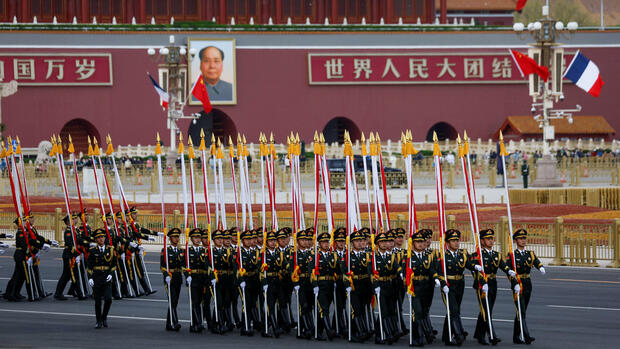Soldiers in Beijing: The Chinese population hardly has to worry about rising prices.
(Photo: Reuters)
Dusseldorf China seems to live in a parallel world when it comes to inflation. In February, the inflation rate was just 1.0 percent year-on-year. In the euro zone, on the other hand, it is 8.5 percent. The core inflation rate, i.e. excluding volatile food and energy prices, which is rising in the euro zone and was 5.6 percent in February, was only 0.6 percent in China.
It is a phenomenon how quickly delays in the supply chain in China have translated into inflation here, but how much the country is now shielded from the inflationary dilemma of the euro zone and the USA. And not just in the short term because of the Covid lockdowns last year. In the second largest economy in the world, inflation rates have hardly ever risen above two percent since the outbreak of the pandemic at the end of 2019 – and according to economists the trend is likely to continue.
There are four reasons for this – and this development will continue to present China with different monetary policy challenges than Europe or the USA.
Reason 1: Weak growth and weak consumption
China’s massive Covid restrictions in 2022 have throttled economic growth to just 3 percent last year. For 2023, the state leadership expects around five percent. Nevertheless, economists from the International Monetary Fund (IMF), for example, see that China’s actual economic growth will be well below potential growth for the current year. That affects the price level.
Above all, private consumption has so far not been the hoped-for growth driver in China. Consumers are unsettled after the Covid lockdowns and are hesitant to spend money.
Reason 2: Hardly any energy price inflation
In China, after the outbreak of the Russian war in Ukraine in February 2022, energy prices did not drive up inflation as much as in Europe. This has to do with long-term supply contracts – and with the fact that China has bought up Russian oil at cheaper prices.
>> Read also: Comment – Opec is pursuing an oil price policy without any regard for the consequences
The recent rise in oil prices should also be reflected in Chinese inflation figures, but not as much as in other countries.
The monthly view of inflation drivers also shows that food prices were a bigger driver than energy prices in the second half of 2022. When it comes to the composition of the Chinese shopping basket, groceries and especially pork are of central importance. The rise in the price of pork is also one reason why the IMF is projecting inflation at 1.9 percent by the end of this year.
Reason 3: Restrained fiscal and monetary policy
Due to the rapid economic recovery already in the second quarter of 2020, the Chinese leadership did not have to counteract a Covid recession as massively as the USA or Europe with economic stimulus packages and interest rate cuts.
In the weekly column we take turns writing about innovation and economic trends in Asia.
(Photo: Klawe Rzeczy)
China’s top monetary policy maker, Yi Gang, can remain at the helm of the central bank and he is convinced that China’s cautious monetary policy has created the environment for high-quality growth. That sounds very much like a continuation of previous policies.
Reason 4: Hardly any supply chain bottlenecks
The supply chain problems are not and have not been that high in China. This is partly due to the fact that it was precisely the foreign exports from China that triggered the bottlenecks in Europe as a result of the Covid restrictions. In addition, the excess demand was not that great due to the delayed economic development in China. The International Monetary Fund does not expect any major problems with demand and supply when the Chinese economy reopens.
Other columns in the Asia Technonomics series:
In its country report published in February, the IMF forecasts a slight increase in inflation to 1.9 percent at the end of the year and then a fall again to 1.7 percent at the end of 2024. The IMF sees the core inflation rate at 2.0 percent at the end of this year and 2.3 percent at the end of next year. In terms of inflation, China is likely to continue to live in a parallel world.
In the Asia Techonomics column, Nicole Bastian, Sabine Gusbeth, Dana Heide, Martin Kölling and Mathias Peer take turns writing weekly about the most exciting technological and economic trends in the world’s most dynamic region.
More: China policy – This is what Macron and von der Leyen want to achieve in China
